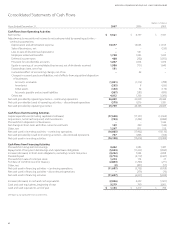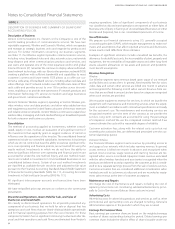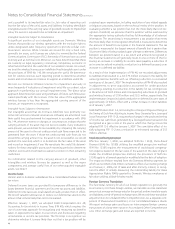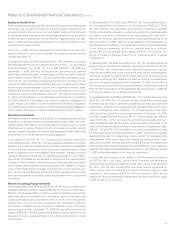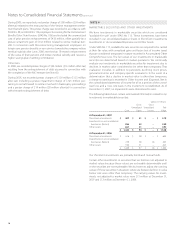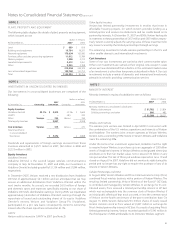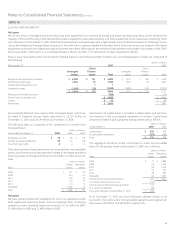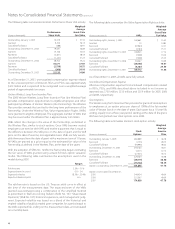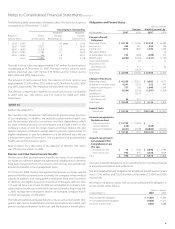Verizon Wireless 2007 Annual Report Download - page 54
Download and view the complete annual report
Please find page 54 of the 2007 Verizon Wireless annual report below. You can navigate through the pages in the report by either clicking on the pages listed below, or by using the keyword search tool below to find specific information within the annual report.
Notes to Consolidated Financial Statements continued
52
The following table summarizes the allocation of the cost of the merger
to the assets acquired, including cash of $2,361 million, and liabilities
assumed as of the close of the merger.
(dollars in millions)
Assets acquired
Current assets $ 6,001
Property, plant & equipment 6,453
Intangible assets subject to amortization
Customer relationships 1,162
Rights of way and other 176
Deferred income taxes and other assets 1,995
Goodwill 5,085
Total assets acquired $ 20,872
Liabilities assumed
Current liabilities $ 6,093
Long-term debt 6,169
Deferred income taxes and other non-current liabilities 1,720
Total liabilities assumed 13,982
Purchase price $ 6,890
The goodwill resulting from the merger with MCI is included in our
Wireline segment, which includes the operations of the former MCI. The
customer relationships are being amortized on a straight-line basis over
3-8 years based on whether the relationship is with a consumer or a busi-
ness customer since this correlates to the pattern in which the economic
benefits are expected to be realized.
We recorded certain severance and severance-related costs and contract
termination costs in connection with the merger, pursuant to EITF Issue
No. 95-3, Recognition of Liabilities in Connection with a Purchase Business
Combination. The following table summarizes the activity related to these
obligations during 2007:
(dollars in millions)
At December 31,
2006 Payments
At December 31,
2007
Severance costs and contract
termination costs $ 376 $ (340) $ 36
The remaining contract termination costs at December 31, 2007 are
expected to be paid over the remaining contract periods through 2008.
In 2007 and 2006, we recorded pretax charges of $178 million ($112
million after-tax) and $232 million ($146 million after-tax), respectively,
primarily associated with the MCI acquisition that were comprised of
advertising and other costs related to re-branding initiatives, facility exit
costs and systems integration activities.
NOTE 8
MERGER AND ACQUISITIONS
Completion of Merger with MCI
On January 6, 2006, after receiving the required state, federal and inter-
national regulatory approvals, Verizon completed the acquisition of 100%
of the outstanding common stock of MCI, Inc. (MCI) for a combination
of Verizon common shares and cash. MCI was a global communications
company that provided Internet, data and voice communication services
to businesses and government entities throughout the world and con-
sumers in the United States.
The merger was accounted for using the purchase method in accordance
with SFAS No. 141, and the aggregate transaction value was $6,890 mil-
lion, consisting of $5,829 million of cash and common stock issued at
closing, $973 million of consideration for the shares acquired from entities
controlled by Carlos Slim Helú, net of the portion of the special dividend
paid by MCI that was treated as a return of our investment, and closing
and other direct merger-related costs. The number of shares issued was
based on the “Average Parent Stock Price,” as defined in the merger agree-
ment. The consolidated financial statements include the results of MCI’s
operations from the date of the close of the merger.
Allocation of the cost of the merger
In accordance with SFAS No. 141, the cost of the merger was allocated
to the assets acquired and liabilities assumed based on their fair values
as of the close of the merger, with the amounts exceeding the fair value
being recorded as goodwill. The process to identify and record the fair
value of assets acquired and liabilities assumed included an analysis of
the acquired fixed assets, including real and personal property; various
contracts, including leases, contractual commitments, and other busi-
ness contracts; customer relationships; investments; and contingencies.
The fair values of the assets acquired and liabilities assumed were deter-
mined using one or more of three valuation approaches: market, income
and cost. The selection of a particular method for a given asset depended
on the reliability of available data and the nature of the asset, among
other considerations. The market approach, which indicates value for a
subject asset based on available market pricing for comparable assets,
was utilized for certain acquired real property and investments. The
income approach, which indicates value for a subject asset based on the
present value of cash flow projected to be generated by the asset, was
used for certain intangible assets such as customer relationships, as well
as for favorable/unfavorable contracts. Projected cash flow is discounted
at a required rate of return that reflects the relative risk of achieving the
cash flow and the time value of money. Projected cash flows for each
asset considered multiple factors, including current revenue from existing
customers; distinct analysis of expected price, volume, and attrition
trends; reasonable contract renewal assumptions from the perspective of
a marketplace participant; expected profit margins giving consideration
to marketplace synergies; and required returns to contributory assets. The
cost approach, which estimates value by determining the current cost of
replacing an asset with another of equivalent economic utility, was used
for the majority of personal property. The cost to replace a given asset
reflects the estimated reproduction or replacement cost for the property,
less an allowance for loss in value due to depreciation or obsolescence,
with specific consideration given to economic obsolescence if indicated.


